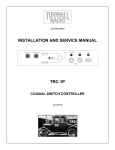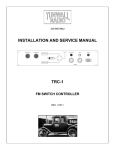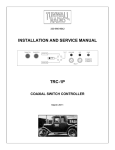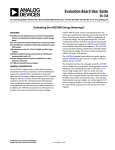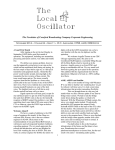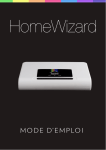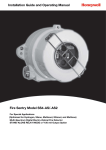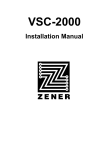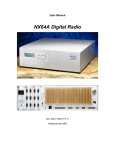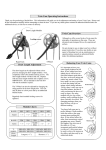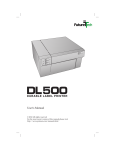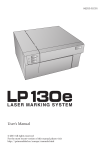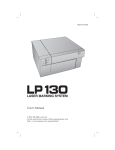Download 330-995-9642 INSTALLATION AND SERVICE MANUAL
Transcript
330-995-9642 COMBINED ANT COMBINED LOAD ANT TX 1 SEPARATE TX 1 LOCAL MODE AUTO SW 1 SEPARATE TX 2 SW 3 COMBINER REJECT LOAD PLATES ON POWER PLATES OFF TX 2 SW 2 TX 3 DUMMY LOAD TRC-3 TRC-3 FM SWITCH CONTROLLER FOR 3 COAX SWITCHES AND COMBINER INSTALLATION AND SERVICE MANUAL Rev Sept 2007 TRC-3 3-Switch FM controller–general ----------------------2 PLC (programmable logic controller) -----------------------2 CONNECTIONS -----------------------------------------------3 Coax switch connections -----------------------------------3 Remote control connections --------------------------------4 Coax switch reverse jumpers -------------------------------4 Transmitter interlock connections -------------------------5 Transmitter 2 analog/digital connections ------------------5 Dummy load connection -------------------------------------6 Plates on/off connections ---------------------------------6 Auto transfer connections ---------------------------------7 Optional connections --------------------------------------7 Reject load interlock connection --------------------------8 OPERATION -------------------------------------------------8 Antenna system modes --------------------------------------9 Illuminated pushbuttons -----------------------------------9 Plates on/off ---------------------------------------------9 Auto transfer key switch ----------------------------------9 Remote control commands ----------------------------------10 Local key switch -----------------------------------------10 Fuses ----------------------------------------------------10 Command polarity -----------------------------------------10 Controller schematic diagram -----------------------------11 Interconnection chart ------------------------------------12 Coax switch wiring charts --------------------------------13 Front panel indicator combinations -----------------------14 Logic tables ---------------------------------------------15 Component layout -----------------------------------------16 Dielectric 50000 series switch manual -------------------1-7 Dielectric 60000 series switch manual ------------------1-10 Appendix A “FM Control system Principles” -----------3 pages IF THE CONTROLLER WILL NOT ALLOW TRANSMITTERS TO RUN IN COMBINED MODES, CHECK THAT THE REJECT LOAD INTERLOCK (TB6, PINS 1 AND 4) HAS A JUMPER OR IS CONNECTED TO THE LOAD. IF THE CONTROLLER WON’T MOVE THE COAX SWITCHES, CHECK THAT THE TRANSMITTER OFF TALLIES (TB6, PINS 5 AND 9 TO PIN 1) HAVE JUMPERS OR ARE CONNECTED TO THE TRANSMITTERS. TRC-3 3-SWITCH FM CONTROLLER This is a controller for three coaxial switches, two or three transmitters, one antenna, combiner, and a dummy load. It was designed for Dielectric 50000 and 60000 series coax switches but will also work with others. All connections are either made to barrier strip terminals or 9-pin AMP connectors on the back panel. The controller has no memory of what the coax switch positions were the last time it was on. It will not move coax switches when powered on. If the coax switches are in a valid combination of positions, the controller will enable the appropriate transmitter interlocks. If any coax switches are between positions when the controller is powered on, it will not do anything, but any local or remote command will move all switches to the correct positions. PLC (PROGRAMMABLE LOGIC CONTROLLER) This is a PLC-based controller. All functions are controlled by a NAIS FP0-C14RS programmable logic controller, with 3 FP0-C16RS expansion modules. Programmable logic controllers are not well known to broadcast engineers but have been widely used in the manufacturing industry for decades. The FP0 is a microprocessor controller, built into a convenient package that includes input isocouplers, output relays, status indicators, terminals and connectors, and a programming interface. PLC’s are designed and constructed to survive and perform in the environments found in industrial facilities, which typically present several challenges to electronic equipment; heat, dust, vibration, magnetic fields, and power line transients. No knowledge of PLC programming is needed to install and use the controller. The PLC uses EEP-ROM for program memory. No backup battery is required, so program loss should not be a concern, even if the controller is unplugged for months or years. The PLC and expansion unit in this controller have opto-isolated electronic logic inputs, and relay contact outputs. All controller inputs are configured for contact closure equipment (such as a Burk ARC-16 remote control with IP-8 relay panels). COAX SWITCHES AND CONTROLLERS If you’re not familiar with FM control systems, or coax switches and their control and status signals, Appendix A “FM Transmitter Control Systems General Terms and Principles” may be of interest. Tunwall Radio LLC 1312 Suffield Oaks Lane Suffield, OH 44260 [email protected] 330-995-9642 2 CONNECTIONS Barrier strip terminals are provided for transmitter and remote control connections All barrier strip terminals are max 24VDC. Coax switch connections are made to 9-pin AMP connectors, which use the same pins as Dielectric 60000 switch connectors. The 9-pin connectors can be installed with several types of pin crimpers commonly used in studio console projects. One suitable tool is Paladin 1645, Newark part #97B3917. Pin 8 of the AMP connector is 120VAC “hot” and pin 9 is AC neutral, used for the motors in 50000 switches. 60000 switches get AC power from a separate power cord. A wiring chart is provided for convenience of installation. If non-Dielectric switches are to be used, connections from representative switch manuals are shown on the coax switch connection chart following the schematic diagram and interconnections pages. Wiring variations in non-Dielectric coax switches, even of the same model number, have been found. Some have internal control relays or not, some have 120V neon indicators or not, and any connections may be different. If the original documentation for your switch is not available, the internal connections should be verified before connection to the controller. Power for the controller can be connected to a UPS, at the engineer’s discretion. The PLC is powered by a switching DC supply that does not usually require protection from transients, or high line voltage – it is designed to operate from up to 250 volts AC. The need for lightning protection is a local decision. The auto transfer function includes a 5 minute power-on delay, to avoid unwanted transfers due to power interruptions. The power-on delay would not work if the controller is powered by a UPS. COAX SWITCH CONNECTIONS – POSITION TALLY CLOSURES The controller needs to know what position the coax switches are in. Pins 1-4 of AMP connectors P1 to P3 are for the coax switch tallies. Each coax switch cable is identical, and combinations of switch positions are handled by coax switch reverse jumpers, described in the jumper section below. COAX SWITCH CONNECTIONS - MOTOR CONTROL RELAYS The controller is compatible with coax switches that have 120VAC, 12VDC or 24VDC motor control inputs/relays. Position change commands are on pins 5-7 of AMP connectors P1 to P3. With 120VAC motor control relays in a 50000 switch, no connection is needed to pin 6. Two internal jumpers on the interconnection board change the command output wiring between 12VCD, 24VDC and 120VAC. For 120VAC relays in 50000 switches only – the Dielectric switch schematic does not exactly match the TR controller diagram. The controller reverses AC line and neutral connections, so that neutral is switched through the controller’s output terminals instead of line. This way, if the controller’s internal voltage select switches are set to 120VAC by mistake, DC relay coils or inputs will not be destroyed. The AC motor in the 50000 switch does not know the difference. 7/8” 50000 switches have DC motors but since they are powered by AC through a transformer and rectifier circuit, this should not matter. Tunwall Radio LLC 1312 Suffield Oaks Lane Suffield, OH 44260 [email protected] 330-995-9642 3 Solenoid-type switches might be compatible with the controller but they are generally considered inferior to motorized types, so no consideration for solenoid switches was given to the controller design. Some Dielectric 50000 switches were shipped with 110VDC relays. These will not work with the controller. In this case you would need to get 12 or 24VDC (or 120VAC) relays, either from Dielectric or from a parts supplier. A (very) few switches may have a 240–120V step-down transformer, which would have to be removed to use the controller. The schematic diagram page indicates the 50000 switch terminal letters, in blue. The interconnection page shows connections for the 60000 switch. The coax switch connection chart following these two pages shows connections for several other coax switches. REMOTE COMMAND CONNECTION Controller terminals TB1-6 to TB1-10 and TB2-1 to TB2-3 are the remote position select and remote plates on/off connections. Floating relay contacts are best, such as the Burk IP-8, but open collector equipment may be used if it is compatible with positive common wiring. REMOTE STATUS CONNECTION The remote control status outputs are connected through diodes to the front panel illuminated pushbuttons. Even though there are multiple PLC expansion modules in the controller, there are a limited number of outputs, not enough for separate local and remote status circuits. The diodes keep the front panel illuminated pushbutton indicators from lighting through the remote control’s pull-up resistors. This status circuit has been used in hundreds of controllers so far, without any reports of a problem. The remote control status outputs are compatible with most remote control systems, Burk as an example. The Burk ARC-16 documentation states that the status inputs can be connected to circuits up to 28 VDC. The only requirement is that one state of the circuit be ground, or near ground. The PLC output relays cause terminals TB1-2 to TB1-5 (TB1-1 common) to go near ground when a remote status indication is on. The remote status outputs follow the 4 system modes; Combined Antenna, Combined Load, etc., not the switch position indicators in the front panel flow chart. COAX SWITCH REVERSE JUMPERS Coaxial switch ports are usually connected to transmitters, antennas, and load according to the physical layout of the equipment and building, rather than arbitrary port number assignments. This can result in different combinations of switch positions for the 4 antenna system modes (Combined Antenna, etc). Rather than wiring switch cables backward when their ports don’t match a fixed controller design, the controller can reverse the front panel indicators, transmitter interlock logic, plate on/off logic, and switch position commands by connecting jumpers on the controller back panel. “Normal” (no reverse jumpers needed) is when all 3 coax switches are in their position 1 when the antenna system is in Combined Antenna mode. If any or all of the coax switches are in their position 2 for Combined Antenna mode, connect a corresponding jumper(s) to the appropriate terminals on TB2 terminals 6-10. Refer to the schematic diagram page on the left side to determine which of these jumpers are needed. TB2-6 and TB2-7 are both +24V common. Tunwall Radio LLC 1312 Suffield Oaks Lane Suffield, OH 44260 [email protected] 330-995-9642 4 The 4 antenna system modes are: Combined Antenna Combined Load Separate TX 1 Separate TX 2 Each of these modes mean two things. The 4 front panel indications (illuminated pushbuttons) and remote status closures could be labeled: Combined Antenna, TX 3 on Load Combined Load, TX 3 on Antenna Separate TX 1 on Antenna, TX 2 on Load Separate TX 2 on Antenna, TX 1 on Load …but room on the front panel for labeling is limited. The antenna system mode needed for load testing and TX 3 on antenna can be easily seen with the front panel graphic display. It doesn’t matter if your system has a third transmitter or not. If #3 is added later, the logic and control is programmed into the controller. The 3 coax switches have 8 position combinations (for any combination of reverse jumpers or none) but only 4 are used or valid. The 4 valid switch position combinations allow all transmitters to get where they need to go, so there are 4 switch combinations that are ignored, as shown on the logic table page. If the switches are manually moved to one of the ignored switch combinations, the controller will not allow any transmitter to run. A valid antenna system mode can be restored with any local or remote command, no matter what positions the switches have been moved to. TRANSMITTER INTERLOCK CONNECTIONS The controller’s interlock terminals are to be connected to the interlock or mute terminals of the transmitters. Older transmitters may not have terminals designated for this purpose, but may have connections for remote plate off. If such a circuit operates with a continuous closure that holds the plate on, the controller’s interlock terminals may be wired in series with this circuit. The PLC’s transmitter interlock outputs are floating relay contacts. The transmitter interlock outputs are normally close-to-run, but jumpers on TB6 can reverse the interlock logic (to open-to-run) for each transmitter individually. Transmitter interlock and plate on/off terminal numbers are shown on the Interconnection page, following the schematic diagram. The PLC relay contacts are rated for 220 VAC. It is up to the engineer’s judgment whether to bring high voltage control circuits out of older transmitters. Since the transmitter control connections are barrier strips, low voltage is better if possible. TRANSMITTER 2 ANALOG / DIGITAL CONTROL CONNECTION Whenever the system is in Separate TX 2 mode, the analog/digital control relay is energized, and terminals TB5-3 (com) and TB5-1 (analog) will be closed. Analog may mean a composite digitaland-analog transmitter mode. When the system is not in Separate TX 2 mode, the relay is not Tunwall Radio LLC 1312 Suffield Oaks Lane Suffield, OH 44260 [email protected] 330-995-9642 5 energized, and terminals TB5-3 (com) and TB5-2 (digital) will be closed. Although the TX 2 control board may be intended to operate from momentary closures, most transmitter control circuits will work properly with continuous interface closures, and not be damaged. For a function like analog/digital, it is usually best to use continuous closures, to lock the function to the antenna system’s operational mode. If the continuous closures are determined to be a problem, an external conversion to a momentary signal will have to be devised. DUMMY LOAD CONNECTION The tally terminals of your dummy load should be connected to controller terminals TB2-4 and TB2-5. The PLC has been programmed to operate correctly with a dummy load contact closure when the blower or water is “on”. This allows the transmitter not on-air to be energized, for testing on the load. When the load is off, the transmitter(s) switched to it will be muted. Filament and blowers should be able to operate, with most transmitters. If the station’s load in a convection type, a switch should be installed in the rack and labeled “Load Interlock”. This way the off-air transmitter(s) will normally not be allowed to run when no one is at the transmitter site, but it is easy to use the switch to allow load testing. A “Load Interlock” switch in series with the load tally contacts might be desirable for Altronic fan loads, due to the nature of their tally contact operation. Altronic tally contacts close any time the load is connected to power. Altronic loads turn on their fans when the load heats up, which protects the load resistors, but the unwanted heat that might result from an accidental plate on command to an off-air transmitter might be a problem for some transmitter buildings. As an alternative, some engineers unplug their Altronic loads when finished with load testing. The controller is able to switch positions when the load interlock is active, but the coax switch is still protected from “hot” switching – the transmitters will be muted. There is a front panel load ready indicator, in the flow chart graphic. PLATE ON / OFF CONNECTIONS “Plate” is traditional; RF on/off or similar is becoming more common. These are floating relay contacts, which should work with any transmitter. There are no separate filament on/off terminals. For most tube transmitters, a cold plate on is not a problem. If the transmitter’s internal control circuits are working correctly, the plate supply will not be turned on until the filament delay runs out. The plate off terminals might be connected to the filament off terminals of a tube transmitter, if you want the filament and blower to shut down when the transmitter is switched off-air. If the transmitter’s internal control circuits are working correctly, the plate will turn off immediately, and the filament time-out will cycle before the blower is turned off. A possible disadvantage to connecting plate off to the filament off circuit is that a transfer from Combined Antenna to a separate mode might cause a filament warm-up delay before getting back on-air. If all of the plate on and plate off closures are connected to your transmitters, the system may be more automatic than you would like. If you don’t plan to use AUTO transfer, you may not want to connect any of the plate control closures. Or, connect just the closures you want. Terminals for plate on/off control are shown on the schematic and interconnection pages. Tunwall Radio LLC 1312 Suffield Oaks Lane Suffield, OH 44260 [email protected] 330-995-9642 6 AUTO TRANSFER CONNECTIONS This is an optional function, selected by a front panel key switch, to transfer to a separate transmitter if a combined transmitter fails. Details on the auto transfer sequence are explained in the OPERATION section. Connections related to auto transfer are made to TB3-7 to TB3-10 and TB4-7 to TB4-10. With auto transfer on, to tell the controller that TX 1 and TX 2 are working, a fail signal for each transmitter must be provided: A continuous closure from floating contacts, maintained when the transmitter is running, or Continuous 5 volts DC when the transmitter is running, which is not connected to ground by the controller The 5 volt option energizes a small single pole relay, whose NO contacts are connected in parallel with the controller’s transmitter fail closure inputs. The current draw of the 5 volt relay is 38ma. The 5 volt relay coils have “protection” diodes, so polarity matters, and is indicated on the schematic drawing and interconnection chart. One transmitter (or RF detector, etc.) can provide a closure and the other can use 5 volts, whichever is available. If a transmitter’s fail closure opens, or if the 5 volt signal drops, the controller will switch the other to the antenna. If both transmitters’ on signals drop at the same time, the controller won’t do anything. The closure or 5 volts can come from the transmitter or any other device such as a Bird Wattcher or suitable modulation monitor. If you only want one transmitter transfer to be allowed, e.g. only TX 1 can be on the antenna by itself, then jumper the TX 2 fail terminals, so it can never “fail”. TRANSMITTER OFF TALLIES The controller can be configured so that coax switches will not be moved without “off” closures from transmitters 1 and 2. Most transmitters would require modification or the addition of a relay or equivalent device. If transmitter off tallies are not used, jumper connections are required between TB6-1 (common) and TB6-4 and TB6-5 or the coax switches will not move. There is no off tally connection for transmitter 3. REMOTE MUTE ALL CONNECTION TB6-2 (TB6-1 common) is an optional connection for a closure to mute all transmitters at any time. REMOTE AUTO KILL CONNECTION Described in more detail in the AUTO transfer operation section. TB6-3 (TB6-1 common) is an optional connection to get out of Separate TX 1 or 2 after a transmitter failure and automatic transfer, by remote control. Tunwall Radio LLC 1312 Suffield Oaks Lane Suffield, OH 44260 [email protected] 330-995-9642 7 REJECT LOAD INTERLOCK CONNECTION If the reject load has an overheat tally contact that opens on overheat, it can be connected between TB6-1 (common) and TB6-9, to shut down transmitters 1 and 2 in combined modes. The reject load interlock has no effect in separate modes. There is no timeout; transmitter interlocks will close immediately when the reject load interlock is restored. If the reject load interlock is not used, a jumper is required between TB6-1 (common) and TB6-9, or transmitters 1 and 2 will not run in combined modes. OPERATION From a single local or remote command, the controller operates the transmitter interlocks and switch motors in a timed sequence such that the switches are never moved with RF power applied. The transmitters are “interlocked” or muted, before the switch motors are energized. Other functions include optional automatic transmitter transfer in case of failure, plate on and off control, and transmitter load testing. ANTENNA SYSTEM MODES The first 4 front panel pushbuttons are the local controls for: Combined Antenna Combined Load Separate TX 1 Separate TX 2 Pushing any of these buttons will lock out the other 3 for the duration of the switching sequence. The switching sequence is: transmitter interlock connections open and plates off; a short delay to let the transmitters’ plate supplies discharge; coax switch operation (as long as it takes up to 30 seconds); at completion of switch movement, interlock on delay, 0.2 second (to let the coax switch settle mechanically, in case the coax switch tally signal is slightly ahead of the absolute end of travel); and transmitter interlock(s) on. The controller has terminals for remote position change commands. These work exactly as the front panel pushbuttons unless the controller is in local. In local, only the front panel pushbuttons are active. After a switch sequence has been started, if the coax switch “hangs”, the transmitter interlocks will not be closed. This is the primary purpose of the controller, of course; preventing the coax switches from being moved under power. If a switch hangs during a transfer and is then manually moved to either position, the controller will enable the interlock(s) for the correct transmitter(s) if the combination of switch positions is valid. This controller is programmed to reset itself after 30 seconds, if a coax switch hangs. After the 30 second time-out, you can try the position change again, or return to the previous position. If the front panel pushbutton for the antenna system mode presently in use is pushed, nothing will happen. If a coaxial switch is moved manually, the transmitter interlocks will open. This doesn’t make it safe or a good idea to move a switch manually under power. If a switch is moved manually, when it “makes” either position, there will be a 0.2 second delay before the transmitter interlocks are restored, if the switch position combination is valid. Tunwall Radio LLC 1312 Suffield Oaks Lane Suffield, OH 44260 [email protected] 330-995-9642 8 ILLUMINATED PUSHBUTTONS The first 4 pushbuttons are illuminated, and show the antenna system mode in use: Combined Antenna Combined Load Separate TX 1 Separate TX 2 Only one of these indicators will be on at a given time. During a transfer sequence, the status indicator for the selected mode will flash. The remote control status outputs flash along with the illuminated pushbuttons. If a coax switch hangs between positions, the controller will reset after 30 seconds, and none of these 4 indicators will be on. After the reset, the failed mode can be selected again, or any of the others. All front panel indicators are solid-state. PLATE ON/OFF If all plate on and off terminals are connected, the control system is fully automatic – for any antenna system command, the transmitter plates will all be turned off, and at the end of the switching sequence, the appropriate transmitters will be turned on. The AUTO key switch has no effect on the plate on/off command outputs. In local, plate on/off are front panel-only functions, but plates are still all turned off automatically by any change sequence. You can connect the plate on or off commands you want to use, or none at all. The plates on and plates off pushbuttons will turn plates on and off for the transmitters active in any of the antenna system modes; e.g. in Combined Antenna, TX 1 and TX 2 will be turned on and off. If the load is running in combined modes, all 3 transmitters will be turned on. There are remote control terminals for Plates on/off. AUTO TRANSFER KEY SWITCH This is a key switch selected option that is only active in Combined Antenna, and it only applies to transmitters 1 and 2. The key switch illuminates the indicator, so although auto transfer is inactive in other antenna system modes, the indicator is on whenever the key switch is in the right position. The AUTO option does not work in local. There are two rear panel indicators, TX 1 and TX 2, that can be verified before turning the AUTO key switch. Auto transfer is not active for 5 minutes after power-on, to help avoid unwanted transfers due to power interruptions. When in Combined Antenna, turn the AUTO key switch to the right to engage automatic transfer. TX 1 and TX 2 transmitter “on” signals have been connected to the transmitter fail closure terminals, according to the AUTO TRANSFER CONNECTIONS section. If either transmitter’s on signal fails for 5 seconds, the controller will switch to the separate mode for the other transmitter. The sequence is the same as if a front panel transmitter change button was used, except that the separate mode’s front panel pushbutton light and remote control output will keep flashing. If both transmitters fail at the same time, the controller won’t do anything. The TX 2 analog/digital relay switches to analog whenever Separate TX 2 mode is active, whether it was selected manually or automatically. Following an auto transfer, none of the local or remote mode change commands will do anything until auto transfer has been reset. Auto transfer can be reset by turning the key switch Tunwall Radio LLC 1312 Suffield Oaks Lane Suffield, OH 44260 [email protected] 330-995-9642 9 off. Auto transfer can also be reset by remote control. Terminals for this are covered in the auto transfer connections section. If auto transfer is reset by remote control, the flashing indicator and corresponding remote control output will stop flashing, and the mode change commands are ready. If a mode other than Combined Antenna is selected next, the auto transfer key switch is ignored. If, after an auto transfer and remote reset, Combined Antenna is selected, you have 60 seconds after the change, plus the 5 seconds failure time, to get both TX 1 and TX 2 running or the controller will transfer to a separate mode again. The 60 seconds does not start until you switch to Combined Antenna mode. REMOTE CONTROL COMMANDS Terminals for 6 remote control command inputs are provided, that duplicate the functions of the 6 front panel position pushbutton switches, except when the local key switch is activated. The front panel pushbuttons operate in local. LOCAL KEY SWITCH The local key switch can be used to lock out remote control commands. The front panel pushbuttons operate in local. The LOCAL and AUTO switches use the same key, which can be removed from either switch in either position. FUSES The front panel DC fuse is on the output of the 24V power supply. 1A should be a good value for this. The AC fuse is in series with the “hot” lead for the entire controller, and the AC power for Dielectric 50000 series coax switches. If no coax switches are powered by the controller, the AC fuse can be about 1A. If 50000 coax switches are used, the AC fuse should be about 3A per switch, since all coax switches will move simultaneously sometimes. Although the AC fuse holder may be labeled 3A, larger or slow-blow fuses can be used at the engineer’s judgment. The internal AC wiring is 18ga, good for at least 10A. The 50000 switch specifications state that the motor inrush current is 3.5A, and the running current is 0.5A. COMMAND POLARITY The header plug labeled “polarity” on the interconnect board is to reverse DC polarity for Andrew/ERI coax switches. The Dielectric configuration shown on the schematic diagram is used for any switch other than Andrew/ERI, as of the time this manual was assembled. Tunwall Radio LLC 1312 Suffield Oaks Lane Suffield, OH 44260 [email protected] 330-995-9642 10 INPUT AND OUTPUT CONNECTIONS MARKED WITH LETTERS ARE TO DIELECTRIC 50000 SWITCH. FOR 60000 OR OTHER SWITCHES, SEE THE CONNECTIONS PAGE. TRC-3 3-SWITCH TRANSMITTER AND COAXIAL SWITCH CONTROLLER COMBINED ANT COMBINED LOAD ILLUMINATED PUSHBUTTONS AROMAT BASE R 11 S P1-2 INPUT 0 SW 1 POS 1 TALLY P1-4 L SEPARATE TX 2 OUTPUT COM 0 34 OUTPUT 0 35 SW 1 POS 2 TALLY 3 INPUT 1 OUTPUT 1 36 4 INPUT 2 OUTPUT 2 37 OUTPUT 3 38 5 INPUT 3 6 INPUT 4 OUTPUT COM 1 39 OUTPUT 4 40 OUTPUT COM 2 41 OUTPUT 5 42 OUTPUT COM 43 P2-1 R P2-2 S SW 2 POS 1 TALLY TB1-1 STATUS COM TB1-2 COMBINED ANT STATUS TB1-3 COMBINED LOAD STATUS TB1-4 SEPARATE TX 1 STATUS TB1-5 SEPARATE TX 2 STATUS P2-3 M P2-4 L SW 2 POS 2 TALLY P3-1 R COAX SWITCH 3 POSITION INDICATOR CONTACTS INPUT COM 2 P1-3 M COAX SWITCH 2 POSITION INDICATOR CONTACTS 1 TO REMOTE CONTROL COAX SWITCH 1 POSITION INDICATOR CONTACTS P1-1 SEPARATE TX 1 P3-2 S SW 3 POS 1 TALLY P3-3 M P3-4 L 7 SW 3 POS 2 TALLY INPUT 5 INPUTS 6 AND 7 NOT USED TB3-1 INTERLOCK TX 1 TB3-2 INTERLOCK TX 1 TB4-1 INTERLOCK TX 2 TB4-2 INTERLOCK TX 2 AROMAT EXPANSION 1 TB2-1 RMT CMD COM TB1-6 FRONT PANEL PUSHBUTTONS COMBINED ANT TB1-7 COMBINED LOAD TB1-8 SEPARATE TX 1 TB1-9 REMOTE CONTROL SEPARATE TX 2 TB1-10 PLATES ON TB2-2 PLATE S OFF TB2-3 T6-2 MUTE ALL T6-3 T6-1 RMT AUTO KILL TB2-6/7 INPUT 20 OUTPUT 20 44 S1 P1 10 INPUT 21 OUTPUT 21 45 S1 P2 11 INPUT 22 OUTPUT 22 46 S2 P1 12 INPUT 23 OUTPUT 23 47 S2 P2 13 INPUT 24 OUTPUT 24 48 S3 P1 14 INPUT 25 OUTPUT 25 49 S3 P2 15 INPUT 26 16 INPUT 27 COAX SWITCH STATUS INDICATORS EACH INDICATOR SHOWN IS ACTUALLY TWO OUTPUTS 26 AND 27 NOT USED DIELECTRIC OUTPUT COM 50 OUTPUT 40 51 17 INPUT COM 18 INPUT 40 19 INPUT 41 20 INPUT 42 OUTPUT 41 52 P1-7 21 INPUT 43 OUTPUT 42 53 P2-5 22 INPUT 44 23 INPUT 45 ANDREW SWITCH 3 REVERSE TB2-9 SWITCH 2 REVERSE TB2-10 SWITCH 1 REVERSE TB6-6 TRANSMITTER INTERLOCK REVERSE JUMPERS TB6-1 COM 9 AROMAT EXPANSION 2 TB2-8 COAX SWITCH POSITION REVERSE JUMPERS INPUT COM NC FP SWITCH SWITCH REVERSE COM 8 INTERLOCK 1 REVERSE TB6-7 P1-6 POLARITY PLUG INTERLOCK 2 REVERSE TB6-8 P1-5 INTERLOCK 3 REVERSE P2-6 OUTPUT 43 54 P2-7 OUTPUT 44 55 P3-5 P3-6 I/O 46 AND 47 NOT USED OUTPUT 45 P3-7 56 24V C COAX SWITCH 1 RELAY COILS N D C COAX SWITCH 2 RELAY COILS N D C COAX SWITCH 3 RELAY COILS N D 12V 7812 AROMAT EXPANSION 3 24 INPUT COM 25 INPUT 60 OUTPUT COM 57 DC TB2-4 LOAD INTLK LOCAL MODE FP SWITCH TB2-5 TB3-7 TRANSMITTER FAIL CLOSURE MAINTAINED FOR TX ON LOAD INTLK AUTO MODE FP SWITCH 26 OUTPUT 60 58 OUTPUT 61 59 TX 1 FAIL CLOSURE TRANSMITTER FAIL CLOSURE MAINTAINED FOR TX ON 60 5V 14 13 TB4-7 38 MA MEASURED @ 5V TB5-2 K5 TB5-1 TX 2 ANALOG MODE K9 OUTPUT 63 61 INPUT 64 OUTPUT 64 5V 62 TX 2 ON IND BACK PANEL 14 13 OUTPUT 65 63 REJECT INTLK 31 INPUT 66 33 INPUT 67 OUTPUT 66 TB4-3 TX 2 PLATE ON 64 TB4-4 TX 2 PLATE ON TB4-5 TX 2 PLATE OFF K4 OUTPUT 67 TB3-6 TX 1 PLATE OFF INPUT 65 K3 TX 2 OFF TALLY TB3-5 TX 1 PLATE OFF K10 TX 1 OFF TALLY TB3-4 TX 1 PLATE ON K2 30 TB3-3 TX 1 PLATE ON K1 29 TX 2 FAIL CLOSURE TB4-10 T6-9 TB5-3 TX 2 DIGITAL / ANALOG COM TB4-9 T6-5 TB5-5 TX 3 INTERLOCK INPUT 63 TX 1 ON IND BACK PANEL TB3-10 T6-4 TB5-4 TX 2 DIGITAL MODE TB4-8 TRANSMITTER FAIL RELAY COIL 5V TB5-7 TX 3 INTERLOCK TB3-9 TRANSMITTER FAIL RELAY COIL 5V TB5-6 TX 3 PLATE ON K6 28 TB5-9 TX 3 PLATE ON INPUT 62 OUTPUT 62 TB3-8 TB5-8 TX 3 PLATE OFF INPUT 61 K7 27 120V TX 3 PLATE OFF K8 65 TB4-6 TX 2 PLATE OFF P1-8 + POWER INDICATOR P1-9 P2-8 24 VOLT POWER SUPPLY L N G P2-9 - A B A B GROUND POWER CORD NEUTRAL AC FUSE LINE TUNWALL RADIO LLC P3-8 TRC-3 TRANSMITTER AND COAXIAL SWITCH CONTROLLER SERIAL 3FM39+ Rev Sept 2007 DRAWN BY S. TUNWALL SHEET 1 0F 2 P3-9 A B SWITCH AND REMOTE CONTROL CONNECTIONS 50000 12 1 60000 DC COAX SWITCH 1 CONTROLLER PLUG 1 60000 AC R 15 15 1 S 16 16 2 POS 1 TALLY 2 POS 1 TALLY M 3 11 11 POS 2 TALLY 4 L 12 12 C 3 22 N 13 D 4 POS 2 TALLY 5 POS 1 COMMAND 6 23 POS 2 COMMAND 8 FUSED 120 VAC 9 24 A B NEUTRAL 3 4 5 6 COMMAND COM 7 CONTROLLER TB 2 7 8 9 10 50000 CONTROLLER PLUG 2 1 60000 DC COAX SWITCH 2 60000 AC R 15 15 S 16 16 1 M 11 11 2 L 12 12 3 C 3 22 4 N 13 D 4 POS 1 TALLY 2 POS 1 TALLY 3 POS 2 TALLY 4 POS 2 TALLY 5 POS 1 COMMAND 6 7 23 POS 2 COMMAND 8 A FUSED 120 VAC 9 24 B NEUTRAL 6 7 8 9 50000 CONTROLLER PLUG 3 1 60000 DC COAX SWITCH 3 60000 AC R/L CHx PLATES ON R/L CHx PLATES OFF LOAD INTERLOCK LOAD INTERLOCK COAX SWITCH REVERSE COM COAX SWITCH REVERSE COM COAX SWITCH 3 REVERSE COAX SWITCH 2 REVERSE COAX SWITCH 1 REVERSE CONTROLLER TB 3 5 COMMAND COM REMOTE INPUT COM 10 R 15 15 S 16 16 M 11 11 1 L 12 12 2 C 3 22 N 13 D 4 TRANSMITTER 1 TX 1 INTERLOCK TX 1 INTERLOCK TX 1 PLATE ON TX 1 PLATE ON TX 1 PLATE OFF TX 1 PLATE OFF TX 1 FAIL CLOSURE TX 1 FAIL CLOSURE TX 1 FAIL RELAY COIL + TX 1 FAIL RELAY COIL - POS 1 TALLY 2 POS 1 TALLY 3 POS 2 TALLY 4 POS 2 TALLY 5 POS 1 COMMAND 6 23 POS 2 COMMAND 8 A FUSED 120 VAC 9 24 B NEUTRAL 3 4 COMMAND COM 7 CONTROLLER TB 4 5 6 7 8 CONTROLLER TB 1 9 1 TRANSMITTER 2 TX 2 INTERLOCK TX 2 INTERLOCK TX 2 PLATE ON TX 2 PLATE ON TX 2 PLATE OFF TX 2 PLATE OFF TX2 FAIL CLOSURE TX2 FAIL CLOSURE TX2 FAIL RELAY COIL + STATUS COM 10 2 3 STATUS CHx COMBINED LOAD 4 REMOTE INPUT COM R/L CHx 7 COMBINED ANT REMOTE CONTROL STATUS CHx SEPARATE TX 2 6 CONTROLLER TB 5 STATUS CHx SEPARATE TX 1 5 1 2 3 4 R/L CHx 8 COMBINED LOAD 5 R/L CHx 9 SEPARATE TX 1 10 TX2 FAIL RELAY COIL - STATUS CHx COMBINED ANT 6 R/L CHx SEPARATE TX 2 7 8 GROUND POWER CORD NEUTRAL 9 TRANSMITTER 3 TX 2 ANALOG MODE TX 2 DIGITAL MODE TX 2 DIGITAL/ANALOG COM TX 3 INTERLOCK TX 3 INTERLOCK TX 3 PLATE ON TX 3 PLATE ON TX 3 PLATE OFF TX 3 PLATE OFF LINE CONTROLLER TB-6 1 2 3 4 5 6 7 8 TUNWALL RADIO LLC 9 TRC-3 TRANSMITTER AND COAXIAL SWITCH CONTROLLER SERIAL 3FM39+ Rev Dept 2007 DRAWN BY S. TUNWALL SHEET 2 0F 2 AUX TB6 COM MUTE ALL RMT AUTO KILL TX 1 OFF TALLY TX 2 OFF TALLY INTERLOCK 1 REVERSE INTERLOCK 2 REVERSE INTERLOCK 3 REVERSE REJECT LOAD INTLK COAX SWITCH CONNECTIONS FOR FM CONTROLLERS DIELECTRIC 50000 DC COMMANDS DIELECTRIC 60000 DC COMMANDS DIELECTRIC 50000 AC COMMANDS DIELECTRIC 60000 AC COMMANDS DELTA ANDREW MCI CONTROLLER Px P1-1 P1-2 13 P1-3 P1-4 P1-5 P1-6 P1-7 P1-8 P1-9 SW1 POS 1 TALLY SW1 POS 1 TALLY SW 1 POS 2 TALLY SW 1 POS 2 TALLY SW1 POS 1 COMMAND COMMAND COM SW1 POS 2 COMMAND FUSED 120 VAC NEUTRAL R 15 R 15 1 4 H S 16 S 16 4 5 J M 11 M 11 14 L L 12 L 12 2 15 M C 3 C 22 6 1 A N 13 3 C D 4 2 B D 23 9 A A 24 3 B B E D ANDREW REQUIRES REVERSE POLARITY HEADER ANDREW 24VDC ONLY DELTA 120VAC ONLY MCI MAY HAVE 5V CONTROL RELAY - CHANGE TO 12V OR 24V TERMINAL NUMBERS FOR DELTA, ANDREW, MCI MAY NOT BE CORRECT FOR EVERY MODEL FRONT PANEL INDICATORS TRC-3 COMBINED ANTENNA COMBINED LOAD ANT TX 1 ANT TX 1 COMBINER COMBINER REJECT LOAD TX 2 REJECT LOAD DUMMY LOAD TX 3 TX 2 SEPARATE TX 1 DUMMY LOAD TX 3 SEPARATE TX 2 ANT TX 1 ANT TX 1 COMBINER COMBINER REJECT LOAD TX 2 14 TX 3 REJECT LOAD DUMMY LOAD TX 2 TX 3 DUMMY LOAD LOGIC TABLES TRC-3 TRANSMITTER INTERLOCK LOGIC TABLES FOR ALL COMBINATIONS OF COAX SWITCH REVERSE JUMPERS ON TB2 15 CAN ALSO BE USED AS COMMAND LOGIC TABLES- RUN = INTERLOCK TERMINALS CLOSED, TRANSMITTER ENABLED MUTE = TRANSMITTER NEVER ENABLED MUTE L = MUTE, BUT TRANSMITTER ENABLED WHEN LOAD IS ON SWITCH CABLES ARE ALL WIRED THE SAME; THE CONTROLLER IS SET TO WORK WITH COAX SWITCH POSITIONS BY REAR PANEL JUMPERS TRANSMITTER INTERLOCKS SYSTEM COMMANDS SWITCHES TRANSMITTER INTERLOCKS TX 1 TX 2 TX 3 SYSTEM COMMANDS SWITCHES TX 1 TX 2 TX 3 COMBINED ANTENNA SW1 POS1 SW2 POS1 SW3 POS1 RUN RUN MUTE L COMBINED ANTENNA SW1 POS2 SW2 POS1 SW3 POS1 RUN RUN MUTE L COMBINED LOAD SW1 POS1 SW2 POS1 SW3 POS2 MUTE L MUTE L RUN COMBINED LOAD SW1 POS2 SW2 POS1 SW3 POS2 MUTE L MUTE L RUN SW1 POS1 SW2 POS2 SW3 POS1 SW1 POS1 SW2 POS1 SW3 POS1 SW1 POS1 SW2 POS2 SW3 POS2 SW1 POS1 SW2 POS1 SW3 POS2 NO JUMPERS REVERSE SW1 JUMPER INVALID INVALID SW1 POS2 SW2 POS1 SW3 POS1 SW1 POS2 SW2 POS2 SW3 POS1 SW1 POS2 SW2 POS1 SW3 POS2 SW1 POS2 SW2 POS2 SW3 POS2 SEPARATE TX 1 SW1 POS2 SW2 POS2 SW3 POS1 RUN MUTE L MUTE SEPARATE TX 1 SW1 POS1 SW2 POS2 SW3 POS1 RUN MUTE L MUTE SEPARATE TX 2 SW1 POS2 SW2 POS2 SW3 POS2 MUTE L RUN MUTE SEPARATE TX 2 SW1 POS1 SW2 POS2 SW3 POS2 MUTE L RUN MUTE TRANSMITTER INTERLOCKS SYSTEM COMMANDS SWITCHES TRANSMITTER INTERLOCKS TX 1 TX 2 TX 3 SYSTEM COMMANDS SWITCHES TX 1 TX 2 TX 3 COMBINED ANTENNA SW1 POS1 SW2 POS1 SW3 POS2 RUN RUN MUTE L COMBINED ANTENNA SW1 POS2 SW2 POS1 SW3 POS2 RUN RUN MUTE L COMBINED LOAD SW1 POS1 SW2 POS1 SW3 POS1 MUTE L MUTE L RUN COMBINED LOAD SW1 POS2 SW2 POS1 SW3 POS1 MUTE L MUTE L RUN SW1 POS1 SW2 POS2 SW3 POS1 SW1 POS1 SW2 POS1 SW3 POS1 SW1 POS1 SW2 POS2 SW3 POS2 SW1 POS1 SW2 POS1 SW3 POS2 REVERSE SW3 JUMPER REVERSE SW1 SW3 JUMPERS INVALID INVALID SW1 POS2 SW2 POS1 SW3 POS1 SW1 POS2 SW2 POS2 SW3 POS1 SW1 POS2 SW2 POS1 SW3 POS2 SW1 POS2 SW2 POS2 SW3 POS2 SEPARATE TX 1 SW1 POS2 SW2 POS2 SW3 POS2 RUN MUTE L MUTE SEPARATE TX 1 SW1 POS1 SW2 POS2 SW3 POS2 RUN MUTE L MUTE SEPARATE TX 2 SW1 POS2 SW2 POS2 SW3 POS1 MUTE L RUN MUTE SEPARATE TX 2 SW1 POS1 SW2 POS2 SW3 POS1 MUTE L RUN MUTE TRANSMITTER INTERLOCKS SYSTEM COMMANDS SWITCHES TRANSMITTER INTERLOCKS TX 1 TX 2 TX 3 SYSTEM COMMANDS SWITCHES TX 1 TX 2 TX 3 COMBINED ANTENNA SW1 POS1 SW2 POS2 SW3 POS1 RUN RUN MUTE L COMBINED ANTENNA SW1 POS2 SW2 POS2 SW3 POS1 RUN RUN MUTE L COMBINED LOAD SW1 POS1 SW2 POS2 SW3 POS2 MUTE L MUTE L RUN COMBINED LOAD SW1 POS2 SW2 POS2 SW3 POS2 MUTE L MUTE L RUN SW1 POS1 SW2 POS1 SW3 POS1 SW1 POS1 SW2 POS2 SW3 POS1 SW1 POS1 SW2 POS1 SW3 POS2 SW1 POS1 SW2 POS2 SW3 POS2 REVERSE SW2 JUMPER REVERSE SW1 SW2 JUMPERS INVALID INVALID SW1 POS2 SW2 POS2 SW3 POS1 SW1 POS2 SW2 POS1 SW3 POS1 SW1 POS2 SW2 POS2 SW3 POS2 SW1 POS2 SW2 POS1 SW3 POS2 SEPARATE TX 1 SW1 POS2 SW2 POS1 SW3 POS1 RUN MUTE L MUTE SEPARATE TX 1 SW1 POS1 SW2 POS1 SW3 POS1 RUN MUTE L MUTE SEPARATE TX 2 SW1 POS2 SW2 POS1 SW3 POS2 MUTE L RUN MUTE SEPARATE TX 2 SW1 POS1 SW2 POS1 SW3 POS2 MUTE L RUN MUTE TRANSMITTER INTERLOCKS SYSTEM COMMANDS SWITCHES TX 1 TX 2 TX 3 SYSTEM COMMANDS COMBINED ANTENNA SW1 POS2 SW2 POS2 COMBINED LOAD SW1 POS2 COMBINED ANTENNA SW1 POS1 SW2 POS2 SW3 POS2 RUN RUN MUTE L COMBINED LOAD SW1 POS1 SW2 POS2 SW3 POS1 MUTE L MUTE L RUN REVERSE SW2 SW3 JUMPERS SW1 POS1 SW2 POS1 SW3 POS1 SW1 POS1 SW2 POS1 SW3 POS2 TRANSMITTER INTERLOCKS REVERSE SW1 SW2 SW3 JUMPERS INVALID SWITCHES TX 1 TX 2 TX 3 SW3 POS2 RUN RUN MUTE L SW2 POS2 SW3 POS1 MUTE L MUTE L RUN SW1 POS1 SW2 POS2 SW3 POS1 SW1 POS1 SW2 POS2 SW3 POS2 INVALID SW1 POS2 SW2 POS2 SW3 POS1 SW1 POS2 SW2 POS1 SW3 POS1 SW1 POS2 SW2 POS2 SW3 POS2 SW1 POS2 SW2 POS1 SW3 POS2 SEPARATE TX 1 SW1 POS2 SW2 POS1 SW3 POS2 RUN MUTE L MUTE SEPARATE TX 1 SW1 POS1 SW2 POS1 SW3 POS2 RUN MUTE L MUTE SEPARATE TX 2 SW1 POS2 SW2 POS1 SW3 POS1 MUTE L RUN MUTE SEPARATE TX 2 SW1 POS1 SW2 POS1 SW3 POS1 MUTE L RUN MUTE 5 COIL 4 NC 1 COM 3 NO 2 COIL 5 COIL 2 COIL 1 COM 24V POWER SUPPLY 4 NC 3 NO CPU EXP EXP EXP TUNWALL RADIO LLC TRC-3 3-SWITCH FM CONTROLLER 16 DRAWN BY S. TUNWALL Sept 2007 Component layout


















